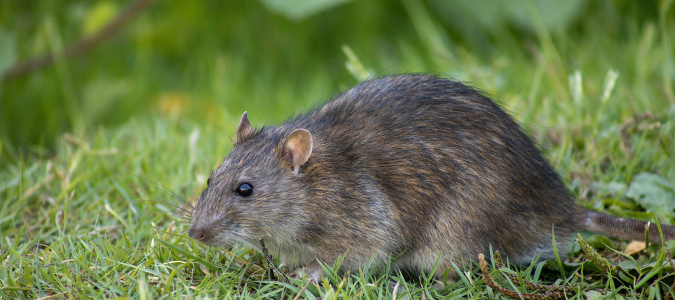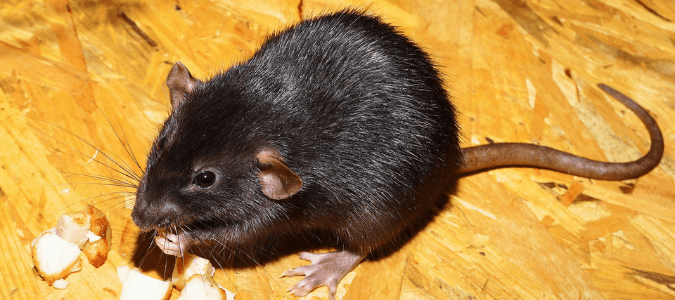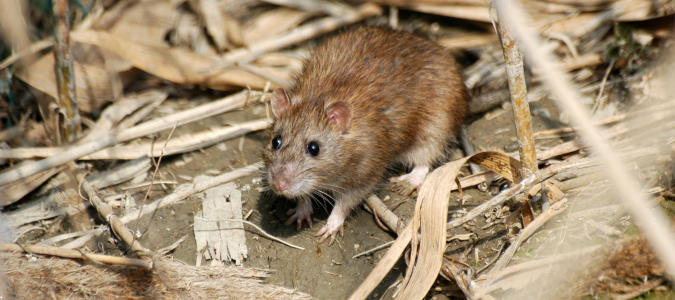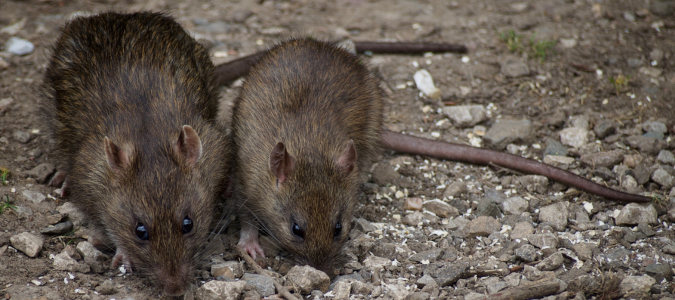Rats can quickly turn a comfortable home into a stressful situation. But the more you understand about their behavior, the easier it is to stop them in their tracks.
For the best results, work with a pest control specialist to control a rat infestation in your home and help deter them from returning.
Where Do Rats Live?
Where rats live depends on their species. Some live in nests while others live in burrows. The most important thing for homeowners to remember is that rats will always choose to live near a reliable source of food and water.
For example, Norway rats, a common species, burrow into the ground to build their nests. They’re often spotted around crawl spaces, the foundation of a home, under concrete slabs or in basements. Outdoors, you may see them under decks, sheds, porches, near woodpiles or around compost heaps.
Rats that burrow are skilled at digging, and they build complex underground tunnel systems that they move through daily. Their tunnels lead them to their food source, water and the nest where adult rats raise their young.
Their burrows have multiple entry points and can be found near garbage bins, compost piles, pet food and other areas where they can access food. Another benefit of their burrows is that they provide shelter from predators.
Another common rat species is the roof rat, which gets its name from their habit of entering homes through the roof. Then they build their nests in elevated areas rather than in the ground.
For instance, roof rat nests are usually found in attics, on rafters and beams, inside wall voids or on eaves. Outdoors, you may spot them inside dense vegetation, such as the ivy that grows on the side of a house, or in tree canopies.
While Norway rats are skilled at digging, roof rats are excellent climbers. They get into your home by climbing up trees and utility lines. They prefer the upper areas of your house because they provide plenty of warmth and shelter.
What Do Rats Look For in a Place to Live?
All rats have three main priorities when looking for a place to build their nests: food, water and shelter. This is why homeowners can find them in unexpected places, such as near clogged gutters or a leaky pipe. Since rats are nocturnal, most of their movement and scavenging happens at night when your home is quiet.
When it comes to food, rats are opportunistic. Rats will eat almost anything they can get their paws on, including pet food, fallen fruit, trash, pantry goods, compost and more.
Rats are nocturnal creatures, so their nest needs to meet their needs. At night, they’ll travel from their nest to the same food and water source over and over again.
Signs of a Rat Infestation
Since rats typically stay out of sight during the day, homeowners are more likely to spot signs of an infestation before seeing an actual rat. For that reason, it’s important to know what to watch out for so you can catch a rat infestation early.
A common sign of rats on your property is rat droppings, which you’ll see along the trail between their nest and their food and water sources. They are small, dark and pellet-shaped droppings that are often found along baseboards.
Next, you may hear rats scurrying around in your walls at night. It will likely sound like a scratching noise coming from your attic or inside your walls.
Rats also leave behind gnaw marks on materials like wood, plastic, drywall and wires. Gnawing helps them maintain their teeth, but it can cause significant damage to your home. Another clue that rats leave behind is grease marks from their fur. You’ll likely see them along your baseboards and walls.
Finally, another sign of a rat infestation is unusual behavior in your pet. If they seem agitated or start acting in a weird way, they may be trying to warn you of a rat infestation.
If you notice any of these signs of rats in your home, do not hesitate to contact a pest control professional.
Common Types of Rats in Texas
The most common types of rats in Texas are roof rats and Norway rats. If you suspect that a rat infestation is in your Texas home, it’s likely one of these species. It’s helpful for homeowners to learn about the appearance and behavior of these rat species so they can spot an infestation before it goes too far.
Roof Rat Identification
Roof rats, pictured above, are dark brown or black rats that are known for their climbing abilities. They have long tails and are typically between 13 and 18 inches long, including their tail. They also have large facial features, such as their large ears and pointed noses.
This species of rat likes to live in elevated places. They’re most commonly found in attics, along rooflines, inside eaves and upper walls, nestled in tall trees or along the rafters in a garage.
They enter homes through gaps in roofs or vents, and only need an opening the size of a quarter. Roof rats can cause significant damage, especially with their teeth. They gnaw through valuable materials like wiring, insulation and more. They can also carry diseases.
If you suspect that you have roof rats in your Texas home, reach out to a pest control specialist.
Norway Rat Identification
Unlike roof rats, Norway rats prefer to live underground. They are excellent diggers and create extensive tunnel systems that keep them safe from predators.
Norway rat bodies are thicker than roof rats, and they also have blunt noses, small ears and shorter tails. Their fur is brown or gray and has a coarse texture, and they measure around 16 inches long, including their tail.
Indoors, Norway rats are commonly found near crawl spaces and inside the walls of lower floors. You may also spot them outside near concrete slabs, the foundation of your home or near woodpiles.
These rats prefer a moist environment, so they are known for infesting older buildings that have drainage issues that can provide ample water sources.
If you suspect that Norway rats have taken up residence in or around your Texas home, call in a pest control specialist.
How to Find Where a Rat is Getting In Your Home
Rats are small creatures that can squeeze themselves through very small holes to enter your home. In fact, most rat species only need an opening the size of a quarter. Even though these pests can squeeze through incredibly small gaps, rats do have bones, and it’s their flexible skeletons that make it possible. For this reason, it’s important to inspect your home and seal up any potential rat entry points.
Start by looking for gaps, holes and cracks along your home’s foundation and walls. You should also check around pipes, utility lines, vents, chimneys, doors and windows.
Be sure to seal any entry points you find to help prevent rats from coming back inside. Working with a pest control specialist is the best way to ensure you’ve properly sealed each entry point.
Another tell-tale sign of a rat infestation is spotting their droppings, gnaw marks or grease marks around the entry points. You may also see loose nesting material, such as shredded paper, fabric or insulation.
If you notice any of these signs of a rat infestation in or near your home, reach out to a pest control expert. Rats are difficult to control on your own and often require professional help.
An expert can control the rat infestation and help you use prevention methods, such as sealing up entry points, to help deter them from returning.
Kick Rats Out of Your Texas Home With Professional Help
It can be very difficult for Texas homeowners to deal with a rat infestation on their own. These pests are elusive, reproduce rapidly and can carry diseases. It’s best to leave control up to a pest control professional who can locate the rat nest and identify their entry points around your home.
From there, an expert can put prevention measures in place. Contact a local pest control company to get started.
ABC Can Help With Any Pest Problems
It can feel frustrating when rats infest your property. Instead of spending your time trying to get rid of rats on your own, contact ABC Home & Commercial Services. Our experts will be able to control the rodents on your property. We will create a custom rodent treatment plan, so you don’t have to worry about these creatures.




